Eduard Vallès
18 November 1939. Camp de la Bota, Barcelona
At a quarter to six in the morning Lluís Serra Giribert (Manresa, 1903 – Barcelona, 1939) was executed by firing squad at Camp de la Bota. He was 36. Born in Manresa, he was adopted by a well-to-do family in Horta de Sant Joan (Terra Alta) because his mother had died in childbirth. At the village school he met Dolors Sancho, whom he later married. They had two children, Lolita and Lluís. When he came of age, he moved to El Prat de Llobregat to work at “La Papelera Española”. There he came into contact with the trade union movement, and he joined the UGT and – spurred on by political events – the PSUC. Serra was elected mayor of El Prat de Llobregat, and he resigned to enlist as a volunteer at the front, although he was later stationed at the airfield in Reus. After the Battle of the Ebre had been lost, it was suggested that he should go into exile from Reus, but he chose to stay with his family, confident that they would not be able to accuse him of anything other than his ideas. He estimated that he might be sentenced to 30 years in prison which would be reduced to 10 or 12 years at the most. But after a summary court-martial in which he was accused of “military rebellion” – something that thousands of soldiers were accused of – he was sentenced to death. He was executed by firing squad after three months of torture in the Model prison in Barcelona, leaving his wife, Dolors, and his 19-month-old son, Lluís. His daughter Lolita had died a few months earlier.
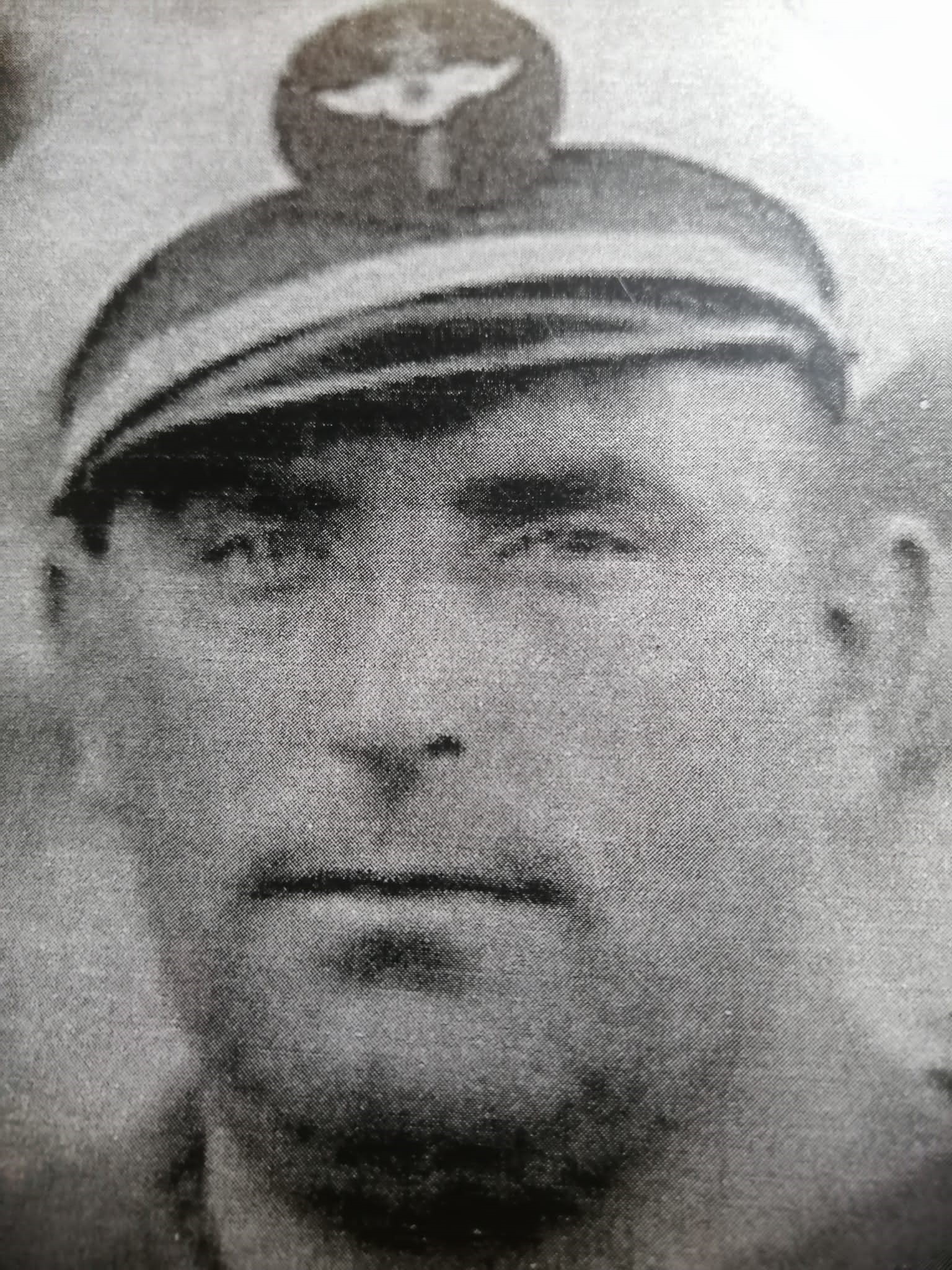
Lluís Serra Giribert, wearing the cap with the air force insignia, at the Airfield in Reus.
14 September 1936. The frontline, Granada
The young Paulina Ódena Garcia (Barcelona, 1911 – Granada, 1936), born in Passatge Pellicer in Barcelona, enlisted as a volunteer in the Civil War in Andalusia, where she happened to be when the war broke out. She joined a column made up mainly of airmen from the airbase at Armilla. Despite her youth, Ódena had been fully active in politics for some years and was a member of the Communist Party. She took up arms during the uprising in October 1934, and due to the 1936 general election that would be won by the Popular Front she accompanied Dolores Ibárurri, La Pasionaria, at some of the meetings she gave in Spain.
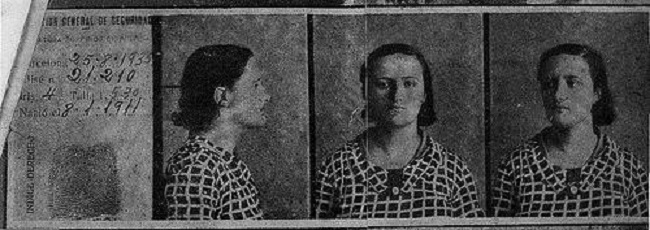
Police file opened on Lina Ódena during the uprising in October 1934.
It seems that in the first few months of the war Ódena ended up playing an important part, and from those days we have some photographs in which she can be seen dressed as a militiawoman, wearing the air force insignia on her chest.
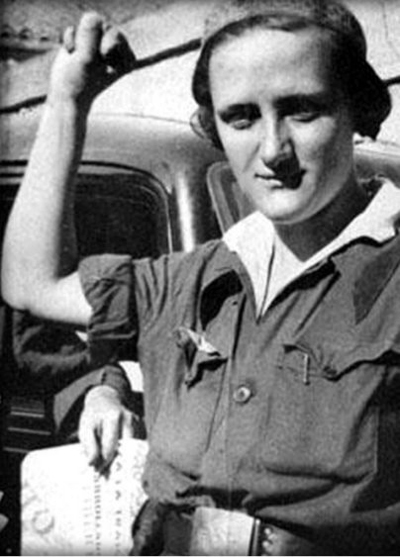
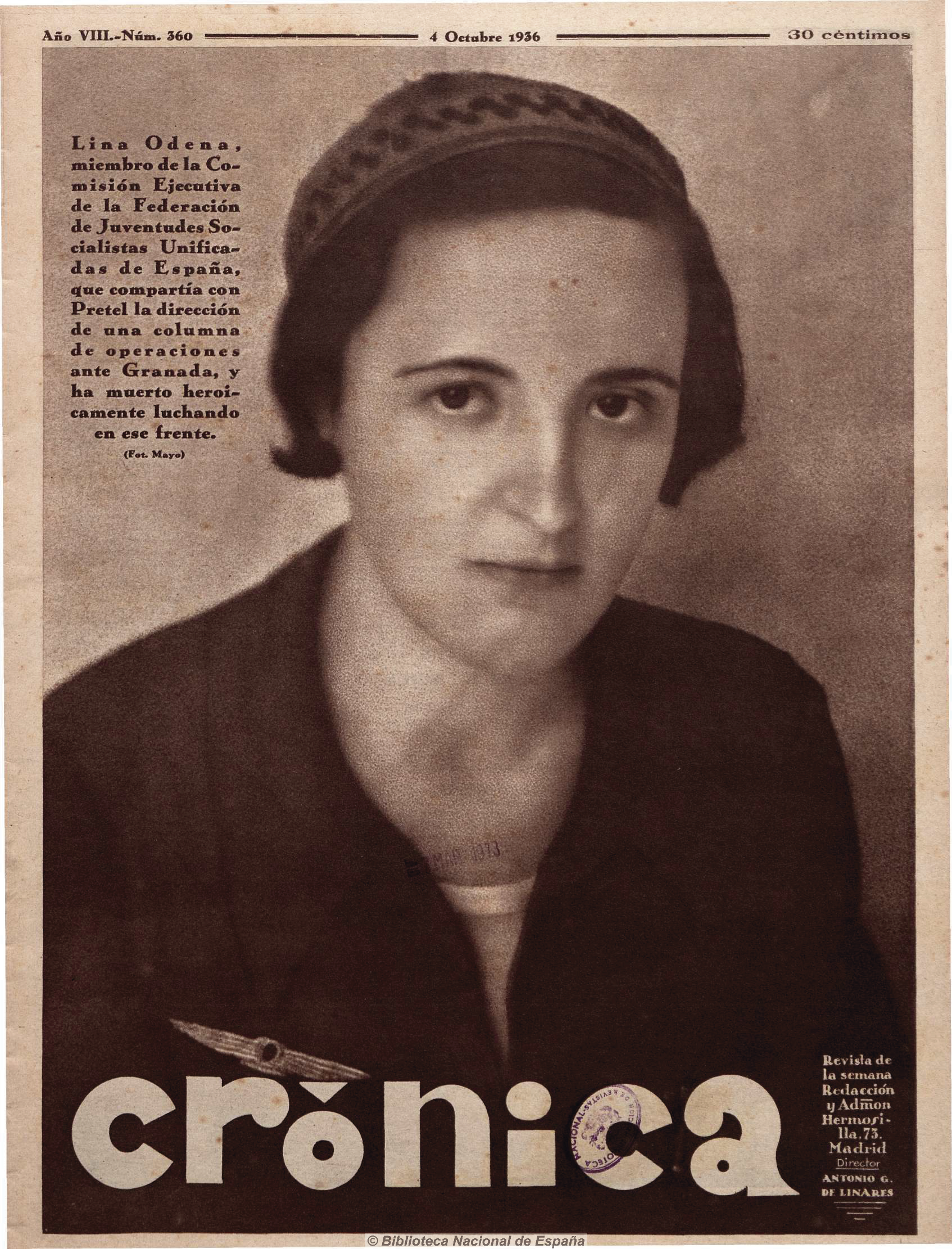
Lina Ódena, in two photographs taken shortly before her death, between July and September 1936, with the air force insignia on her chest.
At the same time, in those days she also worked as a correspondent for the El Mundo Obrero,newspaper, due to her proximity to the war front. On 14 September 1936 – not yet two months after the war had begun – when she was travelling in a car by the Cubillas reservoir, near Granada, her driver approached an army checkpoint. Just as they were about to make contact with them, they realized that they were Falangist soldiers – they had disastrously taken a wrong turning. They attempted to get away but it was too late, and when she felt that she was about to be captured, and knowing perfectly well what awaited her, the young militiawoman shot herself in the head. She was just 24 years old.
It was by no means an anonymous death. In Granada the Ideal newspaper reported it straight away, and even published the photograph of the car in which the young woman was travelling, with the El Mundo Obrero sign and, on the side, the initials U.H.P. (the acronym of the expression Uníos hermanos proletarios).
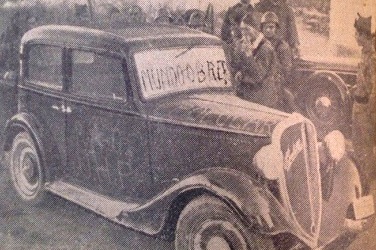
The car in which Lina Ódena was travelling shortly before her death. Photograph from the Ideal newspaper in Granada.
But the projection of her death was even more powerful. As she was a young woman killed in the war, it was used as a propaganda weapon. Cards with her picture on, calendars and stamps were printed, and a battalion made up only of women was even created, called the Lina Ódena Battalion. It is however less well known that her memory was present in the Spanish Pavilion at the 1937 Universal Exhibition in Paris no less, better known as the Pavilion of the Republic. The most iconic work in the Pavilion was undoubtedly Picasso’s Guernica, apart from Miró’s El Segador (The Reaper), now lost, but there was also La Montserrat by Juli González, Mercury fountain by Alexander Calder and the large-format sculpture by Alberto Sánchez, El pueblo español tiene un camino que conduce a una estrella.
La Montserrat, de Juli González, El pueblo español tiene un camino que conduce a una estrella, d’Alberto and El segador, de Joan Miró. ©España. Ministerio de Cultura y Deporte. Centro Documental de la Memoria Histórica. PS-FOTOGRAFIAS, 42-13; 42-11; 42, 28; / Roness-Ruan. © Alberto Sánchez, VEGAP, Barcelona, 2022
But it is a lesser-known fact that hundreds of works by less well-known, or completely unknown, artists were also sent and also exhibited. They were on the whole very uneven in quality, due to the combination of haste and eagerness, but in that wartime context it was imperative for the government of the Republic to provide a response that would be echoed internationally. Among this second level of works an oil painting portrait was sent of Lina Ódena dressed in her militiawoman’s overalls, holding a pistol, with the air force insignia clearly visible. The work appears signed by “J. Pons”, and is part of the Museu Nacional’s collections.

J. Pons. Lina Ódena, 1937. Oil on canvas, 100 × 75 cm. From Exposición Internacional de París, 1937. Museu Nacional d’Art de Catalunya.
In this propaganda/counter-propaganda dialectic, several photomurals made by Josep Renau were also exhibited in the Pavilion of the Republic, one of which showed a militiawoman in action, also in overalls, probably the same age as Lina Ódena.

Fotomural del Pabellón de la República de París realizado por Josep Renau con la imagen de una miliciana.
Therefore the presence of the painting of Lina Ódena in the Pavilion was wholly relevant in this dynamic, but the reading of the work – and its frame, highly distinctive – confirms it. The frame is austere, greenish in colour, and the name of the militiawoman is inscribed at the top in big letters. It is not at the bottom on a small plaque, as is often the case, but it is deliberately visible; in actual fact it functions as a kind of secular altar to a young martyr who had fought for the legitimate government against the military uprising. In this painting, the documentary nature prevails over the artistic, it is a creation made in a rush with just one objective, to be exhibited in the Pavilion of the Republic. The iconography refers us to the famous photograph by Gerda Taro of the militiawoman doing shooting practice on a beach, which could have inspired the painter of the work.

Gerda Taro. [Republican militiawoman training on the beach, outside Barcelona], 1936. Gift of Cornell and Edith Capa, 1986. International Center of Photography
In the background, on the battlefield, a black soldier can be seen, almost certainly a reference to the African troops who fought on Franco’s side. With regard to the colours, it is extremely garish, with the young woman very well dressed and wearing heeled shoes, so from an aesthetic point of view it is closer to a poster than to a conventional painting. When the work returned to Barcelona after being exhibited in the Pavilion, it was hidden in the Palau Nacional building – now the home of the Museu Nacional – for almost five decades, until 1986, when it was exhibited as part of a couple of consecutive temporary exhibitions about the Pavilion of the Republic, one in Madrid and the other in Barcelona. In 2017 it was chosen by the artist Francesc Torres to appear in the extraordinary exhibition The Entropic Box, held at the Museu Nacional, and it was reproduced in the exhibition catalogue. In 2021 it was exhibited permanently for the first time in the Modern Art rooms as a result of the reorganization and enlargement of the Civil War rooms, where it now is.
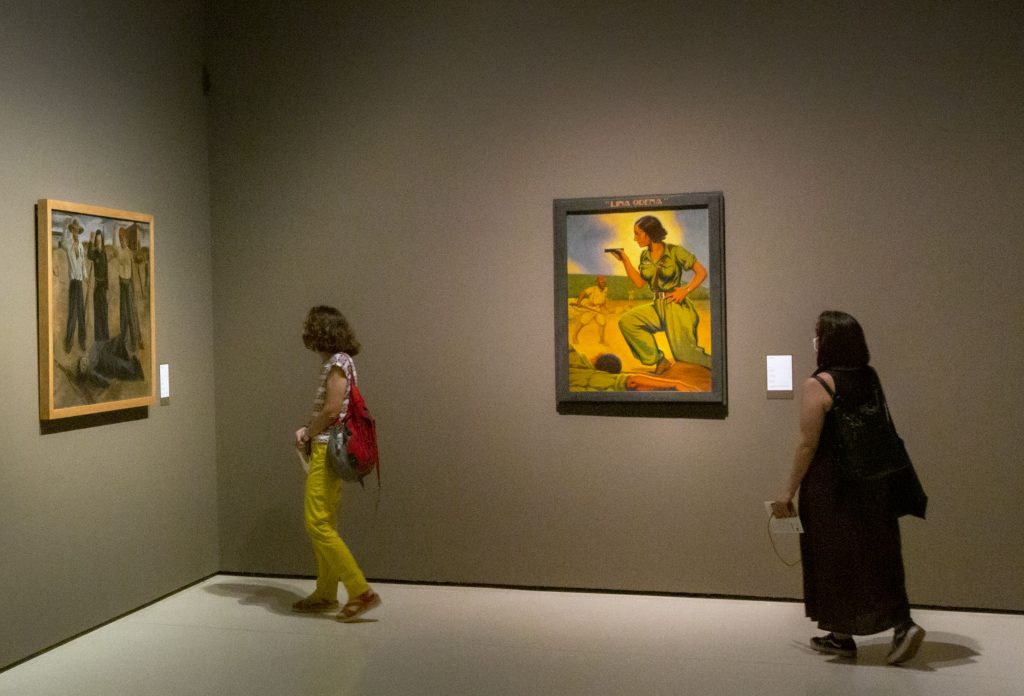
Photograph of the Modern Art room where the portrait of Lina Ódena is exhibited.
19 (?) November 1939. Model Prison, Barcelona
Dolors, Lluís Serra’s wife, went to see him in the Model prison on visiting day, and she became aware of the tragic news when she saw her husband’s name on the feared list of executed prisoners. She went to collect her husband’s personal belongings – most of which had been shared out among his cellmates – and found a goodbye letter addressed to her and their son Lluís, in which he asked her expressly never to hate those who had killed him. Hidden among the folded clothes she discovered a card with the picture of Lina Ódena and the legend “Youthful heroes”, and the words to “The Internationale” in Catalan on the back. This card, however, was returned to her with a bloodstain, still visible after all these years. It is not known who it belonged to.


Front and back of a card with the picture of Lina Ódena and the words to “The Internationale” in Catalan. Lluís Serra Sancho Collection.
10 September 2021. El Prat de Llobregat
On 10 September 2021 his son Lluís, who has kept this document all his life, was present in El Prat de Llobregat at the naming of a boulevard after his father: “Passeig de Lluís Serra Giribert, republican mayor executed at Camp de la Bota”. At the unveiling ceremony of the name plaque, in a gesture full of symbolism, Lluís Serra Jr handed over the mayor’s staff that had belonged to his father to Lluís Mijoler, the current mayor of El Prat. With regard to Lina Ódena, her body was buried in the Patio de la Ermita cemetery in Granada, in grave 122, but over all the years it was never claimed by anybody and it ended up in the common ossuary. Despite that, her memory is very much present in the city of Barcelona. Not only is there a Casal Popular (squatted building) named after her (Passatge de Batlló, 4 bis), but some gardens too, in Carrer de Sardenya.
Art modern i contemporani










